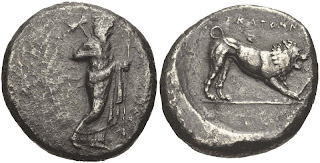Writing more than four hundred years after Alexander, and using a source now lost to us, Plutarch tells the following story:
"Philip himself some time after his marriage dreamed that he set a seal upon his wife's body, on which was engraved the figure of a lion. When he consulted the soothsayers as to what this meant, most of them declared the meaning to be, that his wife required more careful watching; but Aristander of Telmessus declared that she must be pregnant, because men do not seal up what is empty, and that she would bear a son of a spirited and lion-like disposition."
There can be little doubt that the story is false: Aristander came from Telmessus in Caria, and there, the Asia Minor symbology of the lion was well understood.If Philip had related such a dream to Aristander, the interpretation would not have included "spirited and lion-like disposition" but instead would have made a reference to becoming a great king.
 |
Coin of Hekatomnos of Caria. Image courtesy
of
|
The coin on the right was issued by Hekatomnos, Satrap of Caria ca. 392/1 - 377/6 BC. It shows a "heraldic" version of a lion about to spring. This posture is misunderstood in numismatic descriptions of the type, and if it is described at all, the lion is said to be "at bay". The latter posture is shown here. The stance is virtually opposite, with the lion's hindquarters lowered. The symbology of the coin shows that Hekatomnos is ready to defend his territory, but is not about to conquer his neighbours -- something his Persian overlord would not encourage!
I think it most likely that the story was made up to appeal to the western Greeks and to not suggest a Persian-styled ruler who would sweep away democracy with no concern. Remember, Alexander's rule marked the start of the period of the Hellenistic rulers. Today, Alexander is considered a hero by the Greeks but we should also consider the political situation with the Republic of Macedonia that I spoke of in part one of this series. It was very different in the nineteenth century, when the Greeks considered Alexander (and Philip before him) to be the villain who put an end to democracy in Greece. Yannis Hamilakis, _The Nation and its Ruins_, Oxford 2007, p.112, quotes I. Rizos Neroulos: "...And a battle in Charoneia took place, in which Philip won, destroying the Hellenic freedom, But Philip committed something even more disastrous, he fathered Alexander!...". There had to be an interpretation put in place which would explain the imagery on Alexander's seal in the west. Alexander would have needed such imagery in the east as he would be replacing the Persian overlord, and like them, also put native satraps into positions of local government.
In recent years, there has been a proliferation of "repatriation" of cultural objects to their countries of origin. Mostly, these efforts have been aimed at the U.S. The reason given is that they are the heritage of the people in those countries. Sometimes, the objects in question have been spoils of war. It seems to me, though, that these actions are more symbolic of a "passive conquest" in the light of U.S. economic expansion -- a sort of political power play used to bolster public support for the current government of those countries. Sometimes, these objects are put on display to commemorate the action, much like the processions held by the ancient Romans to show the captives and booty brought back by triumphant generals. The U.S. is allowed certain concessions for its generosity, but details of these are never released to the public in either country.
I find it rather amusing that such repatriation efforts could not be applied to the seal in my possession. Whether nationalistic ownership is determined by the country where the seal was found, or the country that includes the ancient state where it was made. No find spot has been recorded and every one of Alexander's officials would have sealed international correspondences with such a seal. Not only can we not know where such letters were sent -- just about all of the ancient world known to the Greeks could be candidates, but we have no idea where the seal was made, nor even from where the seal matrix was made. It's creator could well have been travelling with Alexander. Canadian law is very clear on the matter, if more than one country can have a claim on an object, possession must remain with its current legal owner.
No comments:
Post a Comment